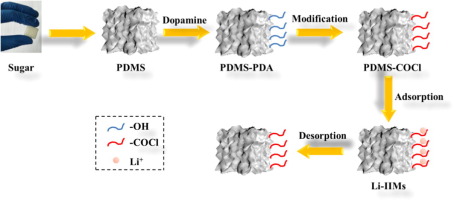当前位置:
X-MOL 学术
›
J. Colloid Interface Sci.
›
论文详情
Our official English website, www.x-mol.net, welcomes your
feedback! (Note: you will need to create a separate account there.)
Bio-inspired fabrication of Ester-functionalized imprinted composite membrane for rapid and high-efficient recovery of lithium ion from seawater.
Journal of Colloid and Interface Science ( IF 9.4 ) Pub Date : 2020-03-30 , DOI: 10.1016/j.jcis.2020.03.091 Chao Yu 1 , Jian Lu 2 , Jingwen Dai 3 , Zeqing Dong 2 , Xinyu Lin 2 , Wendong Xing 2 , Yilin Wu 2 , Zhongfei Ma 4
Journal of Colloid and Interface Science ( IF 9.4 ) Pub Date : 2020-03-30 , DOI: 10.1016/j.jcis.2020.03.091 Chao Yu 1 , Jian Lu 2 , Jingwen Dai 3 , Zeqing Dong 2 , Xinyu Lin 2 , Wendong Xing 2 , Yilin Wu 2 , Zhongfei Ma 4
Affiliation

|
Lithium ion (Li+) is one of the important sustainable resource and it's urgently demanded to develop high-selectivity and high-efficient method to extract of Li+ from seawater. Hence, we propose the ester-functionalized ion-imprinted membrane (IIMs) with high selectivity and stability for the rebinding and separation of Li+ in aqueous medium via ion imprinted technology and membrane separation technology. In this work, the hydrophilic polydimethylsiloxane membranes (PDMS) are synthesized by self-polymerization of dopamine (DA) in aqueous solution, resulting in the fabrication of dense poly-dopamine (PDA) layer on the surface of PDMS (PDMS-PDA). In view of weak bonding forces (such as hydrogen bond, ionic bond and Van der Waals' force) between traditional imprinted polymer and ligand, the ester groups are formed between modified PDMS-PDA and ligand by surface grafting. The obtained Li+ imprinted membranes (Li-IIMs) have a suitable cavity and high adsorption capacity toward Li+ which reveal a high rebinding capacity (50.872 mg g-1) toward Li+ based on ample rebinding sites and strong affinity force. The superior relative selectivity coefficients (αNa/Li, αK/Li and αRb/Li are 1.71, 4.56 and 3.80, respectively) can be also achieved. The selectivity factors of Li-IIMs for Na+, K+ and Rb+ are estimated to be 2.52, 2.8 and 3.03 times larger than Li+ non-imprinted membranes (Li-NIMs), which imply the superior selectivity of Li-IIMs toward Li+. The regeneration ability of Li-IIMs is observed by systematic batch experiments. In summary, it can be concluded that the rebinding capacities of Li-IIMs is slightly decrease after eluting process, owing to the Li-IIMs with outstanding stability performance. Presentation of the method pave a fine prospect for coming true the long-term use of imprinted membrane.
中文翻译:

生物启发的酯基功能化印迹复合膜的制备,可快速高效地从海水中回收锂离子。
锂离子(Li +)是重要的可持续资源之一,迫切需要开发一种高选择性,高效的方法从海水中提取Li +。因此,我们提出了一种具有高选择性和稳定性的酯官能化离子印迹膜(IIMs),用于通过离子印迹技术和膜分离技术对水介质中的Li +进行重新结合和分离。在这项工作中,通过水溶液中多巴胺(DA)的自聚合合成亲水性聚二甲基硅氧烷膜(PDMS),从而在PDMS(PDMS-PDA)表面上形成致密的聚多巴胺(PDA)层。鉴于传统印迹聚合物与配体之间的键合力弱(例如氢键,离子键和范德华力),酯基通过表面接枝在改性PDMS-PDA和配体之间形成。所获得的Li +印迹膜(Li-IIMs)具有合适的空腔和对Li +的高吸附能力,基于充足的结合位点和强大的亲和力,它显示出对Li +的高结合能力(50.872 mg g-1)。还可以获得较高的相对选择性系数(αNa/ Li,αK/ Li和αRb/ Li分别为1.71、4.56和3.80)。Li-IIM对Na +,K +和Rb +的选择性因子估计是Li +非印迹膜(Li-NIMs)的2.52、2.8和3.03倍,这表明Li-IIM对Li +的选择性更高。通过系统的分批实验观察了Li-IIMs的再生能力。综上所述,可以得出结论,由于Li-IIM具有出色的稳定性能,洗脱后Li-IIM的重结合能力会略有下降。该方法的提出为长期使用印迹膜提供了良好的前景。
更新日期:2020-03-31
中文翻译:

生物启发的酯基功能化印迹复合膜的制备,可快速高效地从海水中回收锂离子。
锂离子(Li +)是重要的可持续资源之一,迫切需要开发一种高选择性,高效的方法从海水中提取Li +。因此,我们提出了一种具有高选择性和稳定性的酯官能化离子印迹膜(IIMs),用于通过离子印迹技术和膜分离技术对水介质中的Li +进行重新结合和分离。在这项工作中,通过水溶液中多巴胺(DA)的自聚合合成亲水性聚二甲基硅氧烷膜(PDMS),从而在PDMS(PDMS-PDA)表面上形成致密的聚多巴胺(PDA)层。鉴于传统印迹聚合物与配体之间的键合力弱(例如氢键,离子键和范德华力),酯基通过表面接枝在改性PDMS-PDA和配体之间形成。所获得的Li +印迹膜(Li-IIMs)具有合适的空腔和对Li +的高吸附能力,基于充足的结合位点和强大的亲和力,它显示出对Li +的高结合能力(50.872 mg g-1)。还可以获得较高的相对选择性系数(αNa/ Li,αK/ Li和αRb/ Li分别为1.71、4.56和3.80)。Li-IIM对Na +,K +和Rb +的选择性因子估计是Li +非印迹膜(Li-NIMs)的2.52、2.8和3.03倍,这表明Li-IIM对Li +的选择性更高。通过系统的分批实验观察了Li-IIMs的再生能力。综上所述,可以得出结论,由于Li-IIM具有出色的稳定性能,洗脱后Li-IIM的重结合能力会略有下降。该方法的提出为长期使用印迹膜提供了良好的前景。











































 京公网安备 11010802027423号
京公网安备 11010802027423号